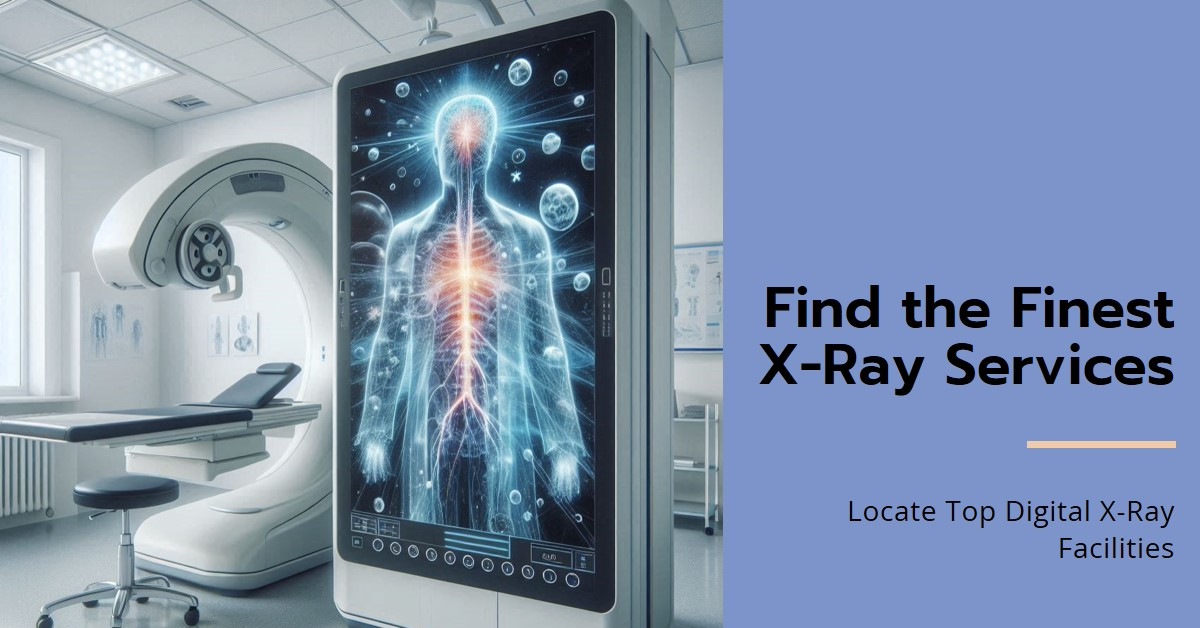In the fast-paced world of modern healthcare, diagnostic imaging plays a crucial role in identifying and treating various medical conditions. Whether you’re dealing with a fracture, lung infection, or dental issues, x-rays offer a reliable way to visualize internal structures. However, with advancements in technology, the traditional x-ray has given way to the more sophisticated digital x-ray. If you’re searching for a “digital x-ray near me,” this article provides a comprehensive guide on what digital x-rays are, how they work, and why they’re beneficial.
What is a Digital X-Ray?
A digital x-ray is a modern form of x-ray imaging where digital sensors are used instead of traditional photographic film. This method allows for faster results, clearer images, and less radiation exposure for patients. The x-rays are transmitted electronically and can be viewed on computer screens or sent directly to your healthcare provider for further analysis.
How Does a Digital X-Ray Work?
Digital x-rays use electromagnetic waves to create detailed images of your bones, tissues, and organs. When the x-ray machine is operated, it emits a controlled amount of radiation that passes through the body. Dense structures like bones absorb more radiation and appear white on the x-ray, while softer tissues allow more radiation to pass through and appear in shades of gray or black.
In contrast to conventional x-rays that require physical film to capture images, digital x-rays store the data electronically. This means the images can be enhanced, zoomed in, or adjusted for contrast, allowing for more precise diagnosis. Digital x-rays can also be shared electronically, speeding up the diagnostic process and making it easier for specialists to consult remotely.
Benefits of Choosing Digital X-Rays
When searching for a “digital x-ray near me,” you’re likely wondering how they compare to traditional x-rays. Here are some of the key advantages of digital x-rays over conventional methods:
1. Lower Radiation Exposure
Digital x-rays require significantly less radiation compared to traditional x-rays. This is especially beneficial for patients who need multiple x-rays over time, such as those monitoring bone fractures, lung conditions, or dental issues. Reduced radiation exposure is safer for both adults and children, giving peace of mind to health-conscious individuals.
2. Faster Results and Improved Diagnosis
Since digital x-rays are stored electronically, the results are available almost instantly. Patients no longer need to wait for film to be developed, which speeds up the diagnosis process. This is particularly important in emergency situations, where timely decisions can make a significant difference in treatment outcomes.
3. Enhanced Image Quality
Digital x-rays offer superior image resolution, which can be adjusted for brightness and contrast. This improves the ability of healthcare providers to detect small fractures, early stages of diseases, or abnormalities that may not be as easily visible with traditional x-rays. Clearer images lead to more accurate diagnoses and more effective treatment plans.
4. Environmentally Friendly
Unlike traditional x-ray machines that use film and chemicals for image development, digital x-rays are a greener option. They eliminate the need for film processing, reducing hazardous waste and lowering the environmental impact.
5. Easily Shareable
Another major advantage of digital x-rays is the ease with which they can be shared with specialists or other healthcare providers. Whether you need a second opinion or a referral to a specialist, digital x-rays can be sent via email or cloud-based platforms, ensuring a seamless flow of information between healthcare professionals.
What to Expect During a Digital X-Ray Procedure
A digital x-ray procedure is simple and non-invasive. Whether you’re visiting a diagnostic center or a hospital, here’s what you can typically expect:
- Preparation: You may be asked to remove any metal objects, such as jewelry, belts, or glasses, as these can interfere with the x-ray. Depending on the part of your body being imaged, you might need to wear a lead apron to protect other areas from radiation exposure.
- Positioning: You’ll be positioned by a radiology technician, who will guide you to either sit, stand, or lie down depending on the area to be examined. The technician will carefully position the x-ray machine to focus on the specific body part.
- Taking the X-Ray: The technician will step behind a protective barrier and activate the machine. You may hear a slight buzzing or clicking sound as the x-ray is taken. It’s important to remain still during this process to ensure a clear image.
- Review: The digital image will appear on the technician’s screen almost immediately. If the image is satisfactory, no further x-rays will be needed. However, in some cases, additional angles may be required to get a comprehensive view.
How Long Does a Digital X-Ray Take?
The actual procedure typically takes just a few minutes. In most cases, the entire process—including preparation—can be completed within 10 to 15 minutes. This makes digital x-rays a quick and efficient option for patients who need fast results.
When Should You Get a Digital X-Ray?
There are numerous situations where a healthcare provider may recommend a digital x-ray. Here are some common reasons why patients seek a “digital x-ray near me”:
- Bone Fractures and Injuries: If you’ve had a recent fall or trauma and suspect a bone fracture, an x-ray will confirm the extent of the injury.
- Chest and Lung Issues: Digital chest x-rays are frequently used to detect pneumonia, bronchitis, and other lung-related conditions.
- Dental Issues: Dentists use digital x-rays to assess cavities, impacted teeth, and bone loss in the jaw.
- Joint and Back Pain: X-rays of the spine, knees, hips, or other joints can help diagnose arthritis, degenerative diseases, or injury-related conditions.
- Follow-up for Chronic Conditions: Patients with chronic conditions such as osteoporosis or scoliosis may require periodic x-rays to monitor their progress and make treatment adjustments as needed.
Finding the Best Digital X-Ray Near Me
When searching for the best digital x-ray near me, there are a few factors to consider to ensure you receive top-quality care:
- Accreditation and Certification: Look for diagnostic centers that are accredited by reputable health organizations. This ensures the facility meets high standards of quality and safety.
- Experienced Radiologists: The skill of the radiologist is crucial to getting an accurate diagnosis. Choose a facility with experienced technicians and radiologists who specialize in the type of x-ray you need.
- State-of-the-Art Equipment: Advanced diagnostic centers invest in the latest imaging technology to offer clearer images and reduce radiation exposure. Look for facilities that mention the use of cutting-edge digital x-ray machines.
- Convenient Location and Scheduling: Choose a center that is conveniently located and offers flexible scheduling. Whether you need an urgent x-ray or a scheduled diagnostic appointment, the facility should accommodate your needs.
- Cost and Insurance Coverage: Make sure to inquire about the cost of digital x-rays upfront. Many diagnostic centers accept insurance, but if you’re paying out of pocket, ask for a detailed estimate. You can also compare prices with other nearby centers to ensure you get the best value.
Frequently Asked Questions (FAQs)
1. Is a digital x-ray painful?
No, the digital x-ray procedure is non-invasive and painless. You may feel a slight discomfort if you need to hold a specific position, but the process is generally very quick.
2. How safe are digital x-rays?
Digital x-rays are safe, and they use significantly less radiation than traditional x-rays. For additional protection, especially in sensitive areas, you may be asked to wear a lead apron.
3. Can I eat before getting a digital x-ray?
For most digital x-rays, there are no restrictions on eating or drinking beforehand. However, if you’re getting a specialized x-ray like a barium swallow, your doctor may give specific instructions.
4. How soon will I get my digital x-ray results?
In most cases, digital x-ray results are available within minutes. Your doctor will be able to view the images almost immediately, allowing for quick diagnosis.
5. Are digital x-rays covered by insurance?
Many insurance plans cover the cost of digital x-rays, but it’s always a good idea to check with your provider beforehand.
Conclusion
Digital x-rays have revolutionized the way medical professionals diagnose and treat a wide range of conditions. With faster results, enhanced image quality, and lower radiation exposure, they offer a superior alternative to traditional x-rays. If you’re looking for a digital x-ray near me, it’s important to choose a facility that meets your needs for quality care, convenience, and affordability. Have you found a trusted diagnostic center near you yet?




